height Citroen JUMPY 2012 2.G Owner's Manual
[x] Cancel search | Manufacturer: CITROEN, Model Year: 2012, Model line: JUMPY, Model: Citroen JUMPY 2012 2.GPages: 268, PDF Size: 9.71 MB
Page 10 of 268
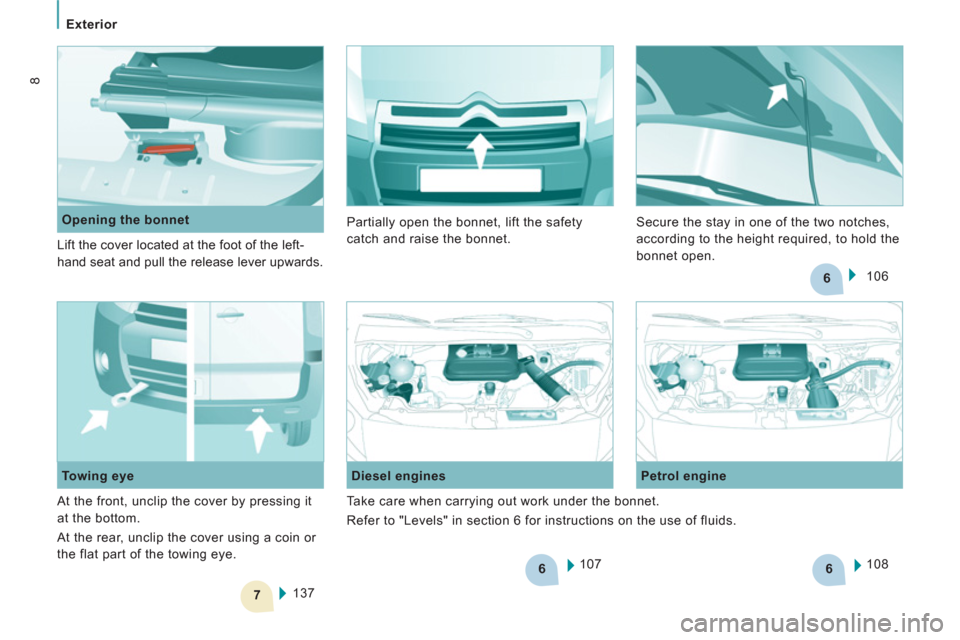
6
7
6
6
Exterior
8
107
Diesel engines
Petrol engine
108
137
Towing eye
Opening the bonnet
Lift the cover located at the foot of the left-
hand seat and pull the release lever upwards.
At the front, unclip the cover by pressing it
at the bottom.
At the rear, unclip the cover using a coin or
the flat part of the towing eye. 106 Partially open the bonnet, lift the safety
catch and raise the bonnet. Secure the stay in one of the two notches,
according to the height required, to hold the
bonnet open.
Take care when carrying out work under the bonnet.
Refer to "Levels" in section 6 for instructions on the use of fluids.
Page 11 of 268
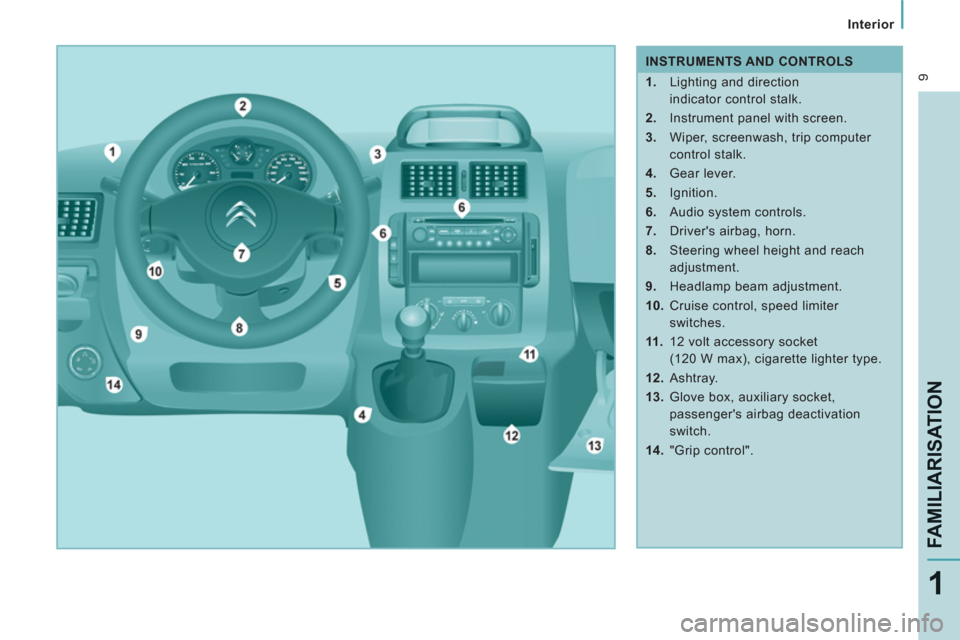
9
Interior
FAMILIARISATIO
N
1
INSTRUMENTS AND CONTROLS
1.
Lighting and direction
indicator control stalk.
2.
Instrument panel with screen.
3.
Wiper, screenwash, trip computer
control stalk.
4.
Gear lever.
5.
Ignition.
6.
Audio system controls.
7.
Driver's airbag, horn.
8.
Steering wheel height and reach
adjustment.
9.
Headlamp beam adjustment.
10.
Cruise control, speed limiter
switches.
11 .
12 volt accessory socket
(120 W max), cigarette lighter type.
12.
Ashtray.
13.
Glove box, auxiliary socket,
passenger's airbag deactivation
switch.
14.
"Grip control".
Page 13 of 268

3
11
Interior
FAMILIARISATIO
N
1
Driver's seat
SITTING COMFORTABLY
1.
Forwards-backwards adjustment.
2.
Backrest angle.
3.
Cushion height.
4.
Lumbar.
5.
Head restraint height.
67
Page 14 of 268
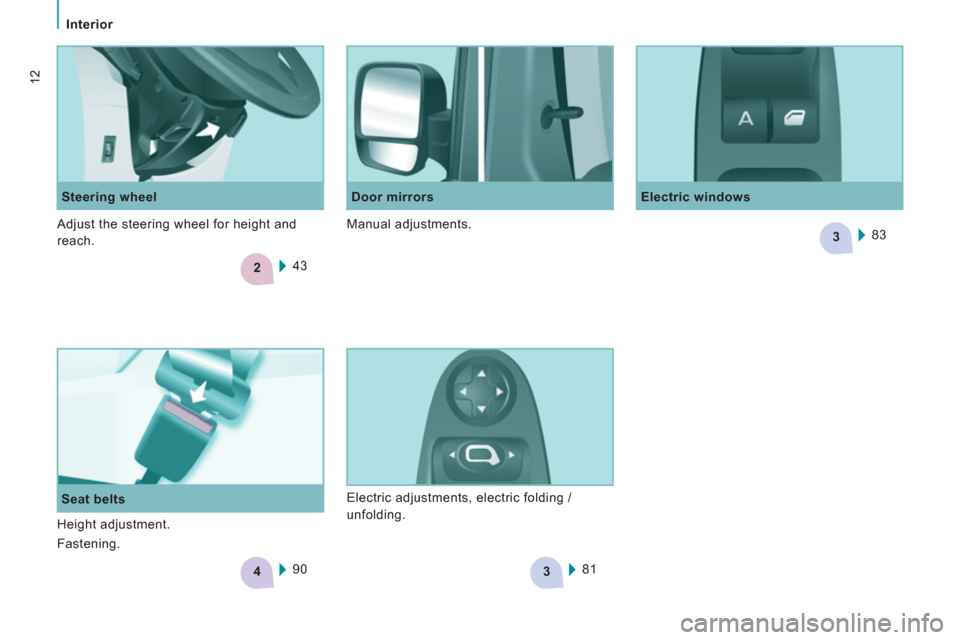
2
4
3
3
Interior
12
Seat belts
Steering wheel
Electric windows
Door mirrors
43
90 83
81 Electric adjustments, electric folding /
unfolding.
Height adjustment.
Fastening. Adjust the steering wheel for height and
reach. Manual adjustments.
Page 34 of 268
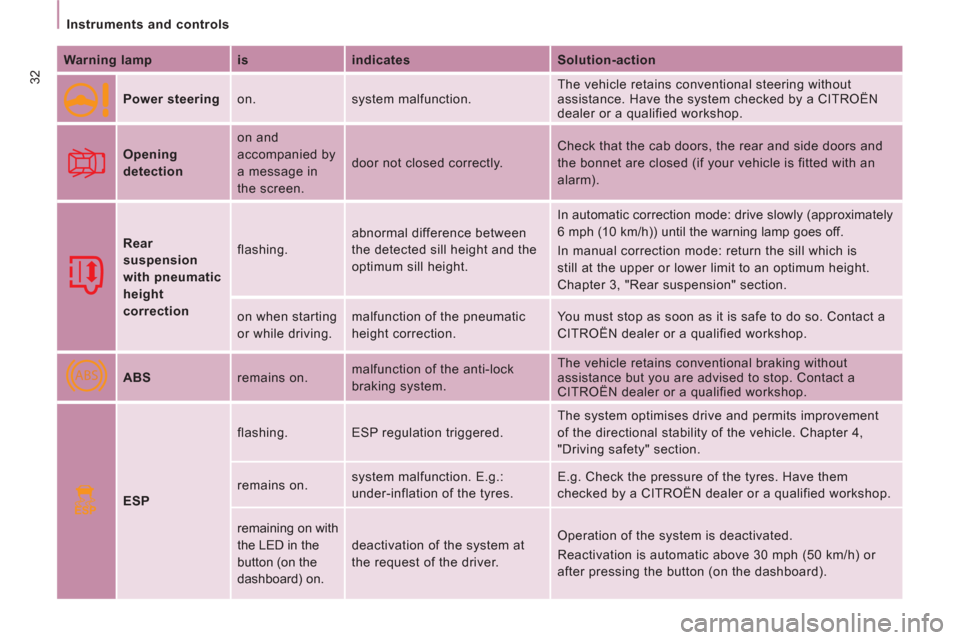
ABS
ESP
32
Instruments and controls
Warning lamp
is
indicates
Solution-action
Power steering on. system malfunction. The vehicle retains conventional steering without
assistance. Have the system checked by a CITROËN
dealer or a qualified workshop.
Opening
detection on and
accompanied by
a message in
the screen. door not closed correctly. Check that the cab doors, the rear and side doors and
the bonnet are closed (if your vehicle is fitted with an
alarm).
Rear
suspension
with pneumatic
height
correction flashing. abnormal difference between
the detected sill height and the
optimum sill height. In automatic correction mode: drive slowly (approximately
6 mph (10 km/h)) until the warning lamp goes off.
In manual correction mode: return the sill which is
still at the upper or lower limit to an optimum height.
Chapter 3, "Rear suspension" section.
on when starting
or while driving. malfunction of the pneumatic
height correction. You must stop as soon as it is safe to do so. Contact a
CITROËN dealer or a qualified workshop.
ABS remains on. malfunction of the anti-lock
braking system. The vehicle retains conventional braking without
assistance but you are advised to stop. Contact a
CITROËN dealer or a qualified workshop.
ESP flashing. ESP regulation triggered. The system optimises drive and permits improvement
of the directional stability of the vehicle. Chapter 4,
"Driving safety" section.
remains on. system malfunction. E.g.:
under-inflation of the tyres. E.g. Check the pressure of the tyres. Have them
checked by a CITROËN dealer or a qualified workshop.
remaining on with
the LED in the
button (on the
dashboard) on. deactivation of the system at
the request of the driver. Operation of the system is deactivated.
Reactivation is automatic above 30 mph (50 km/h) or
after pressing the button (on the dashboard).
Page 45 of 268
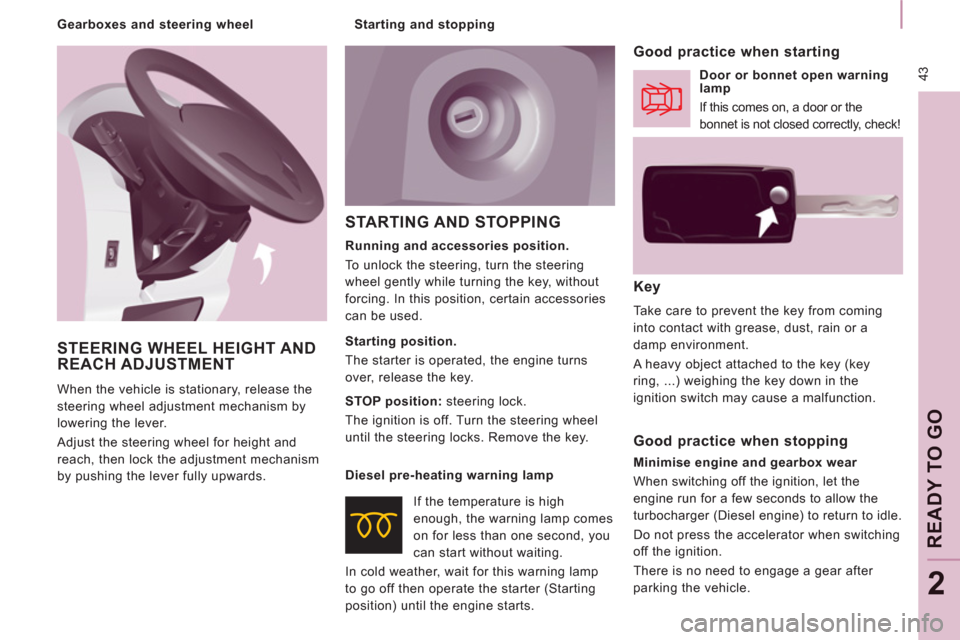
43
READY TO GO
2
STARTING AND STOPPING
Key
Take care to prevent the key from coming
into contact with grease, dust, rain or a
damp environment.
A heavy object attached to the key (key
ring, ...) weighing the key down in the
ignition switch may cause a malfunction.
Good practice when starting
Door or bonnet open warning
lamp
If this comes on, a door or the
bonnet is not closed correctly, check!
Diesel pre-heating warning lamp
If the temperature is high
enough, the warning lamp comes
on for less than one second, you
can start without waiting.
In cold weather, wait for this warning lamp
to go off then operate the starter (Starting
position) until the engine starts.
Good practice when stopping
Minimise engine and gearbox wear
When switching off the ignition, let the
engine run for a few seconds to allow the
turbocharger (Diesel engine) to return to idle.
Do not press the accelerator when switching
off the ignition.
There is no need to engage a gear after
parking the vehicle.
Running and accessories position.
To unlock the steering, turn the steering
wheel gently while turning the key, without
forcing. In this position, certain accessories
can be used.
Starting position.
The starter is operated, the engine turns
over, release the key.
STOP position:
steering lock.
The ignition is off. Turn the steering wheel
until the steering locks. Remove the key.
STEERING WHEEL HEIGHT AND
REACH ADJUSTMENT
When the vehicle is stationary, release the
steering wheel adjustment mechanism by
lowering the lever.
Adjust the steering wheel for height and
reach, then lock the adjustment mechanism
by pushing the lever fully upwards.
Gearboxes and steering wheel
Starting and stopping
Page 69 of 268

67
Seats
EASE OF USE
and COMFOR
T
3
FRONT SEATS
Depending on the version and configuration
of your vehicle, different front seats are
fitted, either:
- a driver's seat and a passenger seat,
- an individual driver's seat and
a two-seat passenger bench.
Depending on the models, the following
adjustments are available:
3 - Driver's seat height adjustment
Depending on the version and configuration
of your vehicle, you have either:
- a passive adjustment: pull the handle
upwards then take your weight off the
seat to raise, or push on the seat to
lower,
2 - Seat back angle adjustment
Pull the lever upwards and set the required
angle.
1 - Forwards/backwards adjustment
Lift the bar and slide the seat forwards or
backwards.
Page 70 of 268
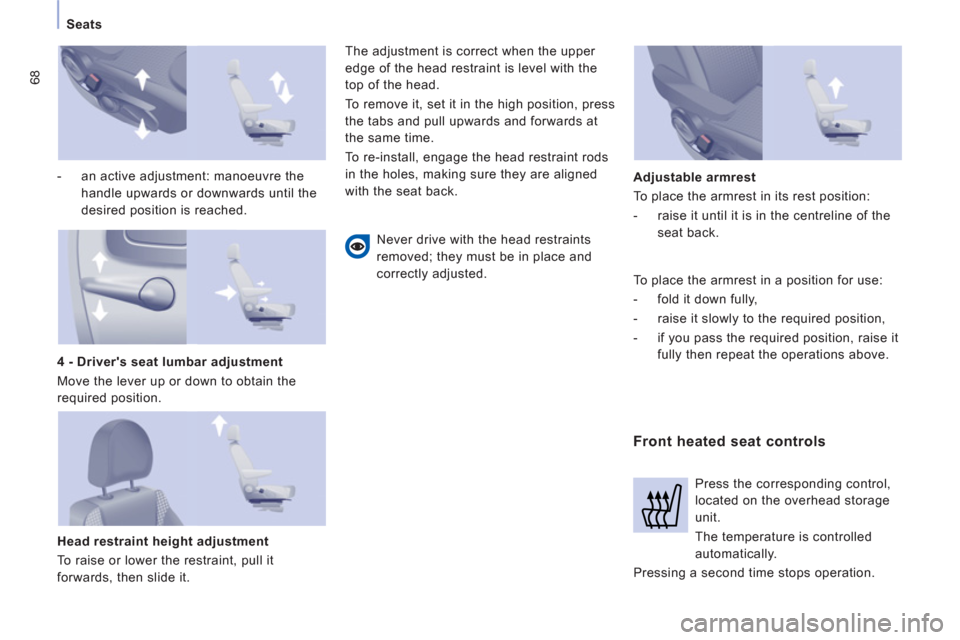
68
Seats
- an active adjustment: manoeuvre the
handle upwards or downwards until the
desired position is reached.
Head restraint height adjustment
To raise or lower the restraint, pull it
forwards, then slide it. The adjustment is correct when the upper
edge of the head restraint is level with the
top of the head.
To remove it, set it in the high position, press
the tabs and pull upwards and forwards at
the same time.
To re-install, engage the head restraint rods
in the holes, making sure they are aligned
with the seat back.
Never drive with the head restraints
removed; they must be in place and
correctly adjusted.
Front heated seat controls
Adjustable armrest
To place the armrest in its rest position:
- raise it until it is in the centreline of the
seat back.
4 - Driver's seat lumbar adjustment
Move the lever up or down to obtain the
required position.
Press the corresponding control,
located on the overhead storage
unit.
The temperature is controlled
automatically.
Pressing a second time stops operation. To place the armrest in a position for use:
- fold it down fully,
- raise it slowly to the required position,
- if you pass the required position, raise it
fully then repeat the operations above.
Page 71 of 268
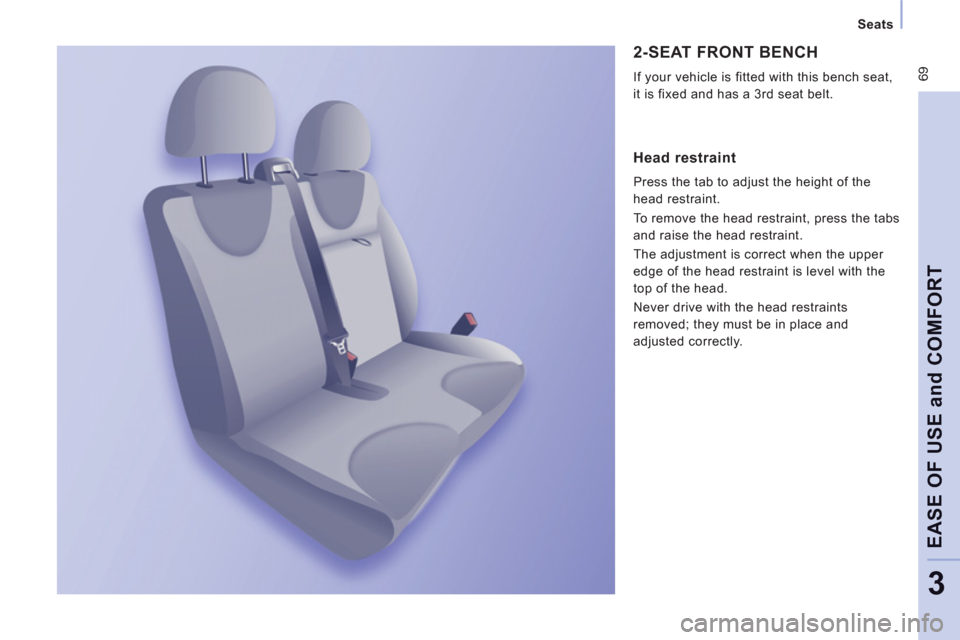
69
Seats
EASE OF USE
and COMFOR
T
3
2-SEAT FRONT BENCH
If your vehicle is fitted with this bench seat,
it is fixed and has a 3rd seat belt.
Head restraint
Press the tab to adjust the height of the
head restraint.
To remove the head restraint, press the tabs
and raise the head restraint.
The adjustment is correct when the upper
edge of the head restraint is level with the
top of the head.
Never drive with the head restraints
removed; they must be in place and
adjusted correctly.
Page 77 of 268

75
Practical information
EASE OF USE
and
COMFOR
T
3
CREW CAB
Bench seat
The crew cab consists of a 3-seat bench,
located in row 2, the one-piece back of
which is fixed to the "load retainer" glazed
partition.
Access to the rear seats is via the sliding
side door.
Head rests and seat belts
Each seat has a head rest adjustable for
height and angle.
The three seats are equipped with inertia
reel seat belts. The seat belts are integral
with the backrest of the bench seat.
Ensure that the seat belt is attached to the
correct buckle.
For more information on the use of this
equipment, refer to "Seat belts" in section 4.
Good practice
The rear seat belt stalks are not designed for securing the load transported. Use the lashing rings on the floor only.
The bench seat of the crew cab is not suitable for the installation of a child seat.
Rear side glasses
If fitted to your vehicle, the side glasses can
be opened.
Squeeze the two controls together then slide
the window. There are 4 position notches.
When driving, the glass should be closed or
secured at one of the 4 notches.